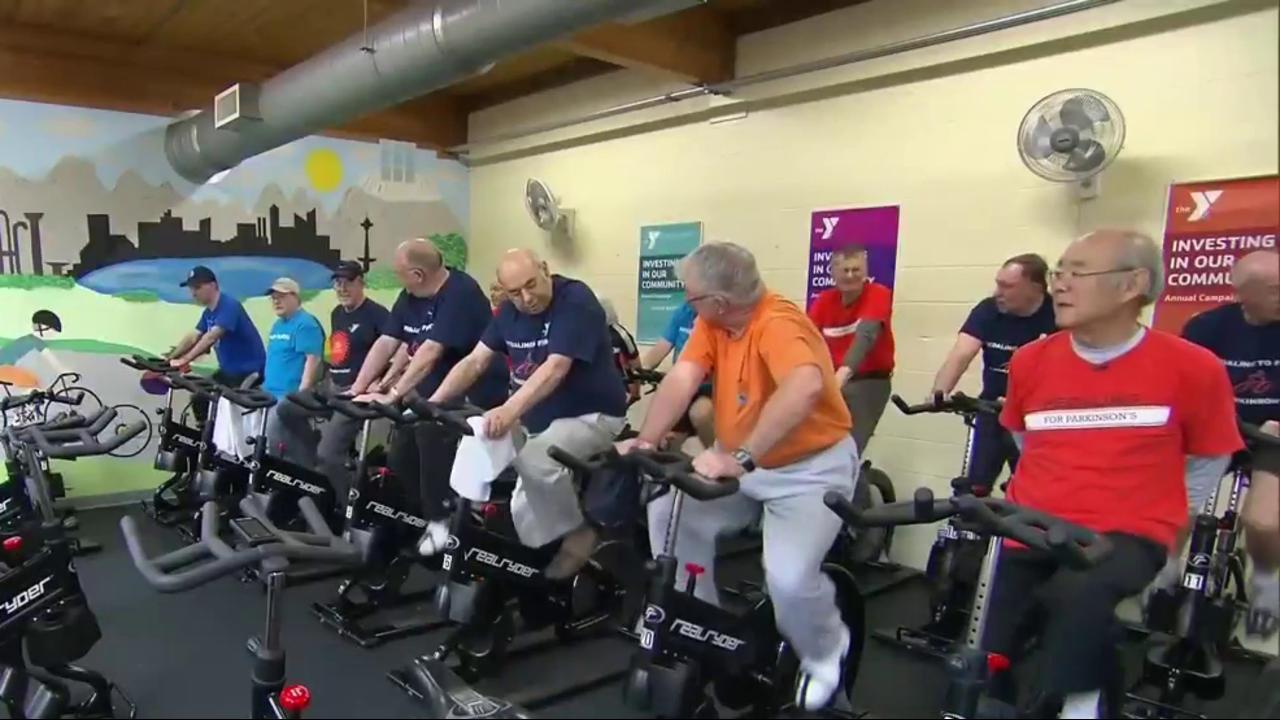Vigorous exercise can slow Parkinson’s
by Maggie Fox /

Geoffrey Rogers knew he felt better after hitting the treadmill.
“When I would finish one of the session there would be a calmness. The tremor would be calm,” said Rogers, a 69-year-old Parkinson’s patient.

Rogers was part of a study released Monday that showed intense exercise can slow the progression of Parkinson’s — enough so patients can notice the difference.
It’s the latest study to show that exercise benefits patients with Parkinson’s, and in this case, shows that patients shouldn’t be shy about pushing themselves and getting sweaty.
In fact, the harder they pushed, the better they did, the team reported in the Journal of the American Medical Association’s JAMA Neurology.
“We gave them a proper workout,” said Daniel Corcos, a professor of physical therapy at Northwestern University Feinberg School of Medicine, who helped lead the study.
“If you have Parkinson’s disease and you want to delay the progression of your symptoms, you should exercise three times a week with your heart rate between 80 to 85 percent maximum. It is that simple.”
RELATED: PINEAPPLE PESTICIDE LINKED WITH PARKINSON’S
Rogers pushed himself four to six times a week as part of the study, cranking up the incline on his home treadmill and walking hard. Afterwards, the tremor that is one of the hallmarks of Parkinson’s would subside for a while, he said.
“It might last 20 minutes or more. It’s not a cure; it’s a way to manage the symptoms,” Rogers told NBC News.
It’s clear that exercise is good for Parkinson’s patients, said Dr. Lisa Shulman, who does her own experiments on exercise and Parkinson’s at the University of Maryland School of Medicine
“The evidence is really very strong at this point. There is sufficient evidence now to warrant a general recommendation,” said Shulman, who was not involved in this study.
Parkinson’s symptoms include tremor, rigid muscles and problems with movement. While early treatment can delay the worst symptoms, people almost always get worse. About 60,000 Americans are diagnosed with Parkinson’s disease each year and about a million Americans have Parkinson’s now.
No medical therapy can cure Parkinson’s and while exercise was always shown to help people feel better, it was not generally accepted as a true therapy until recently.
Now teams are trying to find out how much exercise helps and just which symptoms it affects. Doctors say they’d be thrilled just to slow the inevitable worsening of the disease and if they can freeze progression or reverse symptoms, that would be a home run.
Corcos and colleagues say the most intense exercise appears to have at least temporarily frozen symptoms in many of their volunteers.
“The earlier in the disease you intervene, the more likely it is you can prevent the progression of the disease,” Corcos said in a statement.
“We delayed worsening of symptoms for six months,” he added. “Whether we can prevent progression any longer than six months will require further study.”
RELATED: WALKING HELPS PARKINSON’S
They worked with 128 patients with early stage Parkinson’s. They randomly assigned them to either moderate exercise four days a week, intense exercise four days a week, or no additional exercise.
It’s important to randomly assign people, because it’s possible people who voluntarily exercise more or harder also have different symptoms or less severe disease.
The vigorous exercise group were pushed on a treadmill, with the researchers increasing speed and incline until the volunteers were at 80 to 85 percent of their aerobic capacity, meaning they were breathing hard and probably sweating. Rogers was assigned to this group.
“This is not mild stretching. This is high intensity,” Corcos said.
They were trained at the hospital, and then sent home to exercise as part of their daily lives and asked to send their data to the researchers.
“If you have Parkinson’s disease and you want to delay the progression of your symptoms, you should exercise three times a week with your heart rate between 80 to 85 percent maximum.”
“If you have Parkinson’s disease and you want to delay the progression of your symptoms, you should exercise three times a week with your heart rate between 80 to 85 percent maximum.”
The moderate group were pushed to 60 to 65 percent of capacity, which feels like exercise but doesn’t get the heart pumping as hard.
Maximum heart rate is based on age and there’s a formula for calculating exertion. “An estimate of a person’s maximum age-related heart rate can be obtained by subtracting the person’s age from 220,” the Centers for Disease Control and Prevention says.
The maximum heart rate of a 50-year-old person is 170 beats per minute, so 80 percent of that is 136 beats per minute and 60 percent is 102 beats per minute.
RELATED: GUT GERMS AFFECT PARKINSON’S
For some people, a brisk walk will get them to the 80 percent level, while others may need to be running or walking up a steep incline.
The team also assigned people to exercise four days a week with the hope they would actually do it three days a week, for six months. They did indeed get about three days of week of exercise in both groups.
To determine if patients got better or worse, the researchers used the Unified Parkinson’s Disease Rating Scale. The volunteers were on average at about 20 on the scale, which measures 31 different areas of mood, activity levels and motor skills. Patients score from 0-4 on each and thus the most severe possible score is 124.
After six months, those in the high intensity group were still at about 20, on average.
“I was not getting worse. I was not deteriorating during that period of time,” said Rogers, who also did not take any medication during the experiment.
“You could feel it.”
Those taking moderate exercise worsened very slightly — by about 1.5 points on average, which in any single person would not be noticeably worse. Those who did not exercise worsened by three points on average, which is enough for someone to notice, says Shulman.
Shulman did a similar experiment. She found that no matter how intense the exercise, almost all patients who exercised were later able to walk faster.
RELATED: PARKINSON’S PATIENTS DANCE AWAY THEIR SYMPTOMS
“This was counter to our hypothesis. We thought the higher-intensity group would improve the most,” she said.
Shulman and Corcos agree — exercise isn’t just a feel-good thing that Parkinson’s patients can do as a complementary activity. It’s actual medical treatment.
“We are stopping people from getting worse, which is significant, particularly if we catch them early in the disease,” Corcos said.
“I was not getting worse. I was not deteriorating during that period of time.”
“I was not getting worse. I was not deteriorating during that period of time.”
“It’s part of the idea that exercise is medicine.”
Rogers, who owns a construction business, says he failed to keep up with the exercise program when the study ended four years ago, and his Parkinson’s has worsened since.
“The tremor is more intense. It happens more often,” he said. He has no idea if the symptoms would have worsened had he continued to exercise at the same level he did during the six-month-long study.
But it was hard to work and exercise that much, too, he said.
“It was too much. I am going to slow down, which will free up some time for working out more,” Rogers promised.
